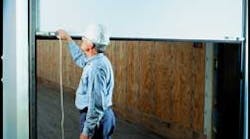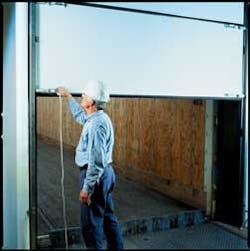Plant managers and other decision-makers often face a "Catch 22" when selecting dock doors for their facilities. On one hand, they realize doors play an integral role in the overall productivity and safety of their operation. On the other hand, many find it difficult to keep pace with ongoing door design developments.
But the selection process doesn't need to be challenging or time-consuming. Five easy steps help guide the dock door selection process and ensure the system chosen produces value in the form of improved safety, increased productivity, lower maintenance, improved owning and operating costs and overall satisfaction.
Step 1: Think safety
Choosing the wrong door may result in a number of safety-related problems ranging from pinched fingers to back injuries to major forklift accidents. The golden rule when it comes to doors is to think safety first to avoid employee injuries and minimize related downtime.
When choosing a dock door, weigh the advantages of counterbalance systems with enclosed counterweights against those of traditional torsion springs. Counterbalance systems help prevent the kinds of accidents that can occur when metal springs lose tension and allow the door to drift into the doorway opening or close prematurely. The worst happens when a forklift strikes the door because the forklift operator fails (or is unable) to notice that the door is partially or fully closed.
A related problem is back injury. As spring tension lessens, the person lifting the door bears the brunt of the weight rather than having the springs do the work. The results are sore or damaged back muscles and potential back injuries that affect workman's compensation insurance.
Counterweighted doors help reduce safety risks because they maintain constant balance without torsion springs. These systems eliminate the potential for the door to drift downward into openings because the doors always remain in balance. In addition, a consistently balanced door makes the task of lifting more effortless.
It's also important to note that cables on both torsion-spring and counterweighted doors can and do break. And once the cable breaks, the results are the same no matter what kind of door is used. Look for a way to guard against cable breakage, particularly on counterbalanced doors.
The enclosed counterweights on this door maintain constant balance without readjustments, preventing the door from drifting down and keeping the task of lifting it strain-free.
Step 2: Weigh maintenance costs
The next step in the door selection process is to consider total ownership and operating costs. Doing so requires a careful analysis of the costs associated with routine maintenance, as well as repairs.
It's obvious that a door of any kind has moving parts, so a planned maintenance program will be needed to achieve peak performance. For example, the spring on most spring-assisted doors needs to be adjusted approximately every six months at an average cost of between $100 and $200 per adjustment. By contrast, a counterweighted door doesn't need to be adjusted because it doesn't use a spring. Instead, the door might need to be realigned every five years or so, if at all, depending on the cycles involved.
The bottom line is to take a close look at the ownership and operating costs throughout the life of the door to determine whether maintenance and repairs will drain the annual budget and whether the premium for low-maintenance features can produce a relatively quick payback.
Step 3: Consider repair costs
Also, dock doors of any kind are susceptible to repeated impact by forklifts. In some cases, a badly damaged door can shut down a loading dock for a day or longer. Dock doors are available with an rugged design that minimizes the potential for damage and the amount of time needed to get a damaged door back up and running.
Some sectional doors, for example, use roller assemblies that pivot to release the door sections from the track when struck by a forklift. The result is greatly reduced damage and downtime. The same door design also allows the door to be reattached without tools or replacement parts to further minimize downtime.
The price tag for replacing bottom panel alone on a single conventional door can easily reach $500, including travel time. If a single roller needs to be replaced, it could reach $150 to $200. Given these factors, the additional cost for a door that withstands impact can make sound financial sense.
Step 4: Energy and security
A door protects against energy loss through insulation and sealing. A reasonable level of insulation is needed to prevent temperature transfer through the door. However, minimizing energy loss also requires tight sealing, even after impact, because a door's ability to seal is more important than its R-value.
The most effective door designs seal around the full perimeter, as well as the space between panel sections.
Optional energy-efficient weather seals prevent gaps at dock-leveler connection points. Lower heating and cooling costs can translate into seal payback within a few months.
Some doors use facings that are affixed to the frame with adhesive strips rather than screws or rivets. In addition to providing a secure bond, strips provide a thermal break that is helpful in refrigerated loading docks where R-value is at a premium.
On the security front, the need to guard against outside intruders has never been greater. This helps explain the concern about the ability of doors that withstand an impact to provide the required level of protection. Some people think these sectional doors must be easy to break into because they break away easily when struck by a forklift. However, new counterweighted doors are equipped with one-way breakaway from the inside out. Only spring-counterbalanced doors require two-way breakaway on dock openings because of the concern of doors drifting closed.
Step 5: Choose the right supplier
The final step to a solid dock door investment is choosing the right supplier. The key is to select a knowledgeable company that can assist with the selection process and provide ongoing support long after the sale.
Al Hochstein, Product Manager, Rite-Hite Doors, Inc., Milwaukee, may be reached at alhochstein@ritehite.com, 414-355-2600.

